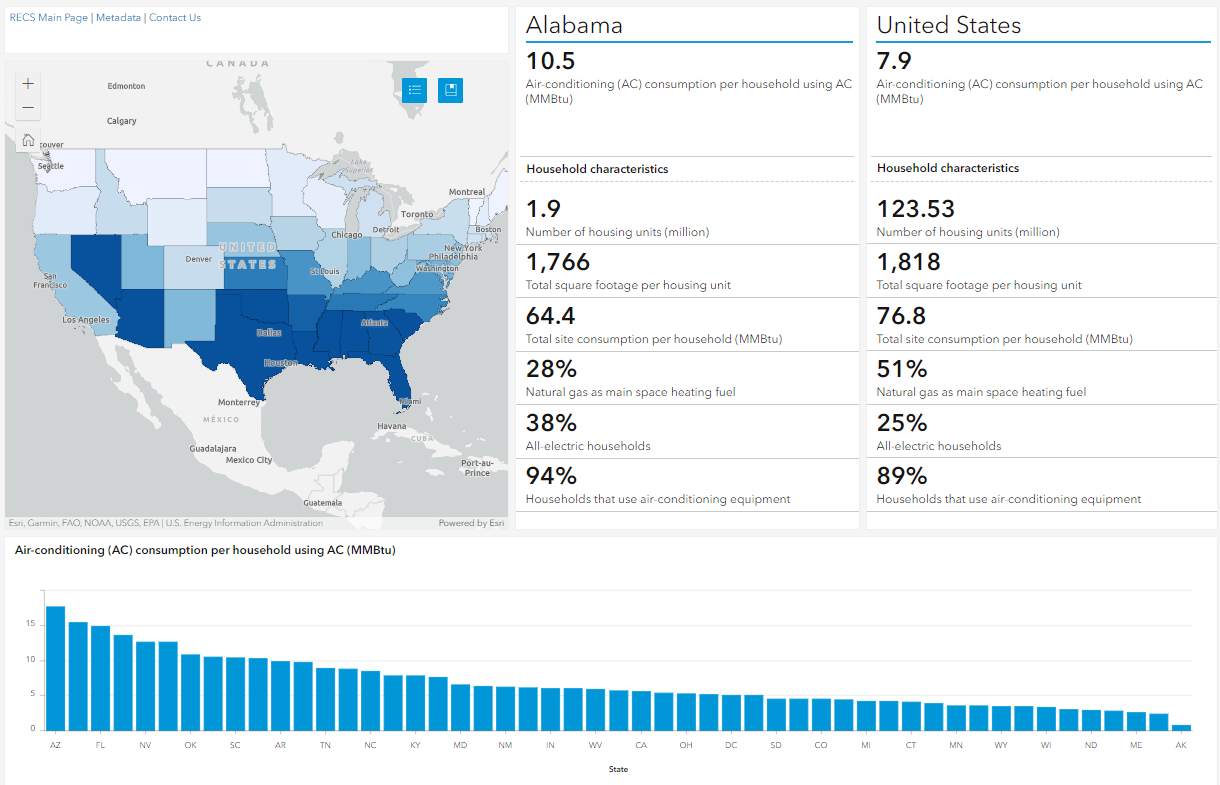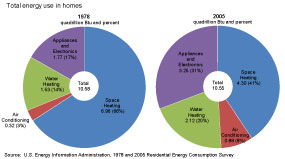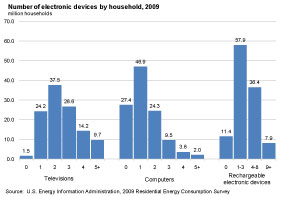Share of energy used by appliances and consumer electronics increases in U.S. homes
RECS 2009 — Release date: March 28, 2011
Over the past three decades, the share of residential electricity used by appliances and electronics in U.S. homes has nearly doubled from 17 percent to 31 percent, growing from 1.77 quadrillion Btu (quads) to 3.25 quads. This rise has occurred while Federal energy efficiency standards were enacted on every major appliance, overall household energy consumption actually decreased from 10.58 quads to 10.55 quads, and energy use per household fell 31 percent.
Federal energy efficiency standards have greatly reduced consumption for home heating
Total energy use in all U.S. homes occupied as primary residences decreased slightly from 10.58 quads in 1978 to 10.55 quads in 2005 as reported by the most recent consumption and expenditures data from the Residential Energy Consumption Survey (RECS). Updated energy consumption data will be available next year. A dramatic reduction in the energy needed to heat homes, along with other efficiency improvements, led to a 31 percent reduction in energy use per household. As a result, total residential energy consumption remained virtually the same.
In 1978, there were 76.6 million occupied housing units in the United States, which used a total of 6.96 quads for space heating. Although the number of homes increased 45 percent to 111.1 million by 2005, they used significantly less energy for heating — just 4.30 quads. The decline is largely due to the improved energy efficiency of heating equipment along with better window design and insulation to more effectively seal homes, although some decline is associated with population movements toward warmer areas.
More homes than ever have and use major household appliances
Initial federal mandatory efficiency standards were enacted between 1988 and 1994 for all major appliances, but energy consumption by household appliances nearly doubled between 1978 and 2005. The 2009 characteristics data are now available from RECS and the 2009 consumption and expenditures data will be available next year. These new characteristics data show that gains in efficiency for these appliances have been offset by other factors including:
- The number of U.S. households grew by 34.5 million from 1978 to 2009
- Improved living standards resulted in more households buying and using major appliances
- The share of households that have central air conditioning nearly tripled, from 23 percent in 1978 to 61% in 2009
- The saturation, or percent of households with an appliance, of clothes washers increased from 74 percent to 82 percent
- The saturation of dishwashers increased from 35 percent to 59 percent
Increased use of consumer electronics has partly offset the efficiency gains of major appliances
Did You Know?
The first digital video recorders (DVRs) shipped in 1999. Ten years later, 43 percent of U.S. households have a DVR player.
While most home appliances have become more efficient over the past 30 years, the average U.S. household uses many more consumer electronics — in particular, personal computers, televisions and related devices.
In 1978, personal computers were expensive and not typically used by U.S. households. In 2009, 76 percent of U.S. homes had at least one computer, eight percentage points more than just four years prior, and 35 percent had multiple computers.
In 1978, most households had only one television. In 2009, the average household had 2.5 televisions. Over 45 percent of homes have at least one television with a screen size of 37 inches or larger. Screen size and average energy consumption per television have continued to grow over time.
DVD players and Digital Video Recorders (DVR), which did not exist 15 years ago, are now widespread. As of 2009, 79 percent of homes had a DVD player, and 43 percent had a DVR. Nearly a third of all households also had at least four electronic devices, such as cell phones, plugged in and charging at home.

 View the dashboard ›
View the dashboard ›

